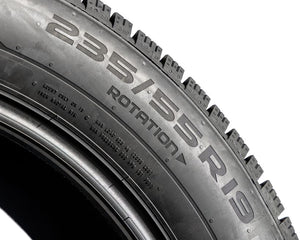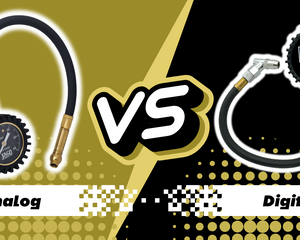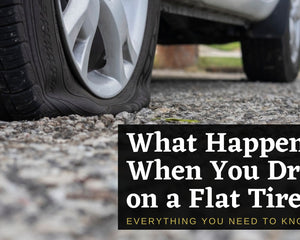
Did you know that the right tire pressure can make your vehicle's handling as smooth as a Broadway dance routine? Not just that, but it also plays a lead role in keeping you safe on the road. Let's embark on this exciting journey to explore the importance of tire pressure in vehicle handling and safety.
Understanding Tire Pressure
Definition and Explanation
Okay, let's first get down to basics. What's tire pressure anyway? In simple terms, tire pressure is the amount of air in your tire. It's measured in pounds per square inch (PSI). But here's the kicker – maintaining the right tire pressure isn't just a good-to-have, it's a must-have!
The Importance of Proper Tire Pressure
Picture this – you're driving down a road that's as smooth as butter, but your ride is bumpy. Your vehicle seems to have a mind of its own, taking its own sweet time to come to a halt when you brake. You feel like you're wrestling with your vehicle to keep it on track. Sounds scary, right? Well, these are just a few of the problems you could face if your tire pressure is off.
Let's put it this way, having proper tire pressure is like having your best foot forward. It ensures your tires wear evenly, your vehicle handles well, and your gas mileage is on point. Now that's a triple threat worth aiming for, don't you think?

Tire Pressure's Impact on Vehicle Handling
Effects on Steering and Maneuverability
So, you might be wondering, how does tire pressure actually impact vehicle handling? Well, let's dive right into it.
First off, think of your car's tires as the prima ballerina in a ballet. They are constantly in touch with the road surface (the stage), performing intricate moves like steering, braking, and accelerating. The right tire pressure ensures these moves are executed flawlessly, giving you the best possible control over your vehicle.
Having the correct tire pressure means your vehicle is able to steer accurately and respond promptly to your commands. This responsiveness isn't just for impressing your passengers with your vehicle's handling; it's vital when it comes to those unexpected situations on the road where a quick maneuver could prevent an accident.
Role in Ensuring a Smooth Ride
Secondly, tire pressure is like the secret sauce to a smooth ride. When it's just right, your vehicle glides over those pesky road bumps, providing you a comfortable journey. Underinflated tires, on the other hand, can give you a ride that's as bumpy as a rollercoaster, and nobody wants to feel like they're on an amusement park ride on their way to work, right?
So, as you can see, tire pressure wears many hats – it's the director, choreographer, and lead performer when it comes to the intricate dance of vehicle handling.

Tire Pressure and Fuel Efficiency
Influence on Gas Mileage
Alright, folks, let's talk dollars and cents. Who doesn't like to save a bit on fuel costs? And guess what, the right tire pressure can help you do just that!
Properly inflated tires minimize resistance with the road, leading to less work for your engine and, voila, better gas mileage! To put it simply, if your tires are perfectly inflated, your vehicle becomes a more efficient machine, using less fuel to take you from Point A to Point B.
The Pitfalls of Overinflation and Underinflation
But, watch out for the two extremes! Overinflated tires can lead to a decrease in the contact surface between the tire and the road. Less contact means less grip and stability, causing your engine to work overtime, thus burning more fuel. Plus, overinflation can cause your tires to wear out quicker and unevenly, leaving you with a rougher ride and more frequent trips to the tire shop. That doesn't sound like fun, does it?
On the other end of the spectrum, underinflated tires create more rolling resistance due to increased contact with the road. Think of it like trying to jog with sandbags tied to your ankles. More work, more energy needed, and in the case of your car, more gas used up!
So, maintaining the right tire pressure not only gives you a smooth, comfortable ride, but it also keeps your wallet happy by reducing fuel consumption. Now that's what we call a win-win!

Tire Pressure and Tire Wear
The Effect of Pressure on Tire Longevity
Alright, let's shift gears and talk about tire longevity. Just like how you wouldn't wear out a pair of high-quality running shoes by wearing them unevenly, you certainly wouldn't want your tires to wear out prematurely due to improper tire pressure, right?
Believe it or not, tire pressure has a substantial effect on tire wear patterns. Overinflated tires tend to wear more in the center, while underinflated tires tend to wear more on the edges. This uneven wear can result in a shortened tire lifespan, meaning more frequent tire replacements and more money out of your pocket. Who wants that?
Maintaining the correct tire pressure ensures an even tire wear, allowing you to get the maximum mileage out of your tires. Even tire wear also contributes to a smooth and comfortable ride. So, next time you think of skipping the routine tire pressure check, remember that a minute spent with your tire pressure gauge can add miles and miles to your tire's life. It's the long game, folks!
Tire Pressure and Safety
Role in Braking Distance and Accident Prevention
Now, this is a biggie. You've probably heard it time and time again: Safety is paramount! And when it comes to tire pressure, we couldn't agree more.
Ever wondered why your car seems to take a bit longer to stop when your tires are underinflated? That's because tire pressure plays a significant role in braking distance. The more underinflated your tires are, the longer your vehicle will take to come to a full stop. So yes, that correct tire pressure might just make the difference between stopping in time or being part of an unfortunate accident.
Risks of Tire Blowouts
And let's not forget the risk of tire blowouts. An overinflated tire can be just as dangerous as an underinflated one. Imagine cruising down the highway when your overinflated tire bursts - not a pleasant thought, right? Overinflation can cause excessive stress on your tire's structure, making it more prone to blowouts, especially when driving at high speeds or on hot days.
So, keeping your tire pressure in check is not just about a smoother ride or better fuel efficiency, it's fundamentally about keeping you and your loved ones safe on the road.

Maintaining Proper Tire Pressure
Regular Checks and Using a Tire Pressure Gauge
Okay, so now that we've hammered home the importance of tire pressure, you might be wondering how to keep those PSI levels in the sweet spot. Fear not, we've got some handy tips and tricks to help you out.
First up, make sure you're checking your tire pressure regularly – at least once a month. But don't just eyeball it, get yourself a reliable tire pressure gauge. Some vehicles come with tire pressure monitoring systems, but a manual check with a gauge is always a good idea for accuracy.
When and How to Check Your Tire Pressure
Always check your tire pressure when your tires are 'cold' – and by cold, we mean when you haven't driven on them for at least three hours. This gives your tires time to cool down and provide a more accurate reading.
But what's the correct pressure, you ask? You'll find that in your vehicle's owner manual or on a sticker in the door jamb or glove box. And remember, your front and rear tires might require different pressure levels.
Also, be sure to check your spare tire. There's nothing worse than getting a flat, only to find out your spare is flat too.
Maintaining proper tire pressure isn't rocket science, but it is a critical part of vehicle maintenance. Regular checks can help ensure optimal vehicle performance and, more importantly, keep you safe on the road.
Final Thoughts
There you have it, folks – a comprehensive look at the absolutely pivotal role that tire pressure plays in vehicle handling and safety. It's more than just a number on your dashboard or a task on your vehicle maintenance checklist. It's a key player in your vehicle's performance, longevity, and, above all, your safety on the road.
Ignoring or underestimating your tire pressure could lead to uneven tire wear, reduced fuel efficiency, poor handling, and an increased risk of accidents. On the other hand, maintaining the optimal tire pressure can save you money, give you a smoother ride, and keep you safer on your travels.
How You Can Stay Prepared
The Role of Tire Pressure Gauges and Inflators
Remember, proper tire pressure maintenance is not a 'set it and forget it' scenario. It needs regular attention and care. And with reliable tire pressure gauges and inflators from JACO, it's easier than ever to stay on top of it.
So, let's make tire safety a priority. Keep an eye on those PSI levels, and don't hesitate to give them a boost if needed. Safe travels!




